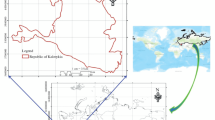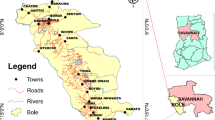Abstract
With the help of the information drawn from a survey of India toposheet and by visual interpretation of satellite imagery of bands 2, 3 and 4, different thematic maps such as geomorphology and lineaments, drainage and land use, and land cover were prepared. These thematic maps have been superimposed and finally a groundwater potential zone map delineated on a survey of India toposheet. The whole block has been demarcated into 5 zones. Zones 1 and 2 are considered ideal groundwater potential areas, zone 3 is moderately ideal, and zones 4 and 5 are unfavourable for groundwater exploration. The validity of demarcation of the study area into different zones, as decided by remote sensing technology, has been justified by analysing the georesistivity sounding data of a number of places in this area. The net potential of the study area is estimated by GEC norm. It is observed that only 11.8% of annual utilisable groundwater is now used and there is vast scope of further exploitation of this resource.
Similar content being viewed by others
References
Agarwal, C. S.: 1989, Geomorphological and structural analysis of Bundelkhand region using remote sensing technique, Proceeding Vol. 1, Second National Symposium on Hydrology J and K, Jan 4–5, I 1–I 12.
Aldrich, R. C.: 1975, Detecting disturbances in a forest environment,Photogrammertic Engineering and Remote Sensing 41, 39–48.
Pant, D. N. and Roy, R. S.: 1990, Vegetation and land use analysis of Aglar watershed using satellite remote sending technique,J. Indian Society of Remote Sensing 18(4), 1–14.
Report on Groundwater Estimation Committee, 1983, Ministry of Irrigation, Govt. of India.
Singh, A.: 1986, Change detection in the tropical forests environment of North-Eastern India using landsat data, in: Eden and J. T. Perry, (eds.),Remote Sensing and Tropical Land Management, John Wiley, New York, pp. 237–253.
Singh, I.: 1989, Monitoring of forest cover type and land use classes through remote sensing techniques, photonirvachak,J. Indian Society of Remote Sensing 17, 15–21.
Sinha, B. K., Kumar, A., Srivastava, D. and Srivastava, S.: 1990, Integrated approach for demarcating the fracture zone for well site location. A case study near Gumla and Lohardaga, Bihar, Photonirvachak,Indian Society of Remote Sensing 18, 1–8.
Author information
Authors and Affiliations
Rights and permissions
About this article
Cite this article
Panigrahi, B., Nayak, A.K. & Sharma, S.D. Application of remote sensing technology for groundwater potential evaluation. Water Resour Manage 9, 161–173 (1995). https://doi.org/10.1007/BF00872127
Received:
Accepted:
Issue Date:
DOI: https://doi.org/10.1007/BF00872127




